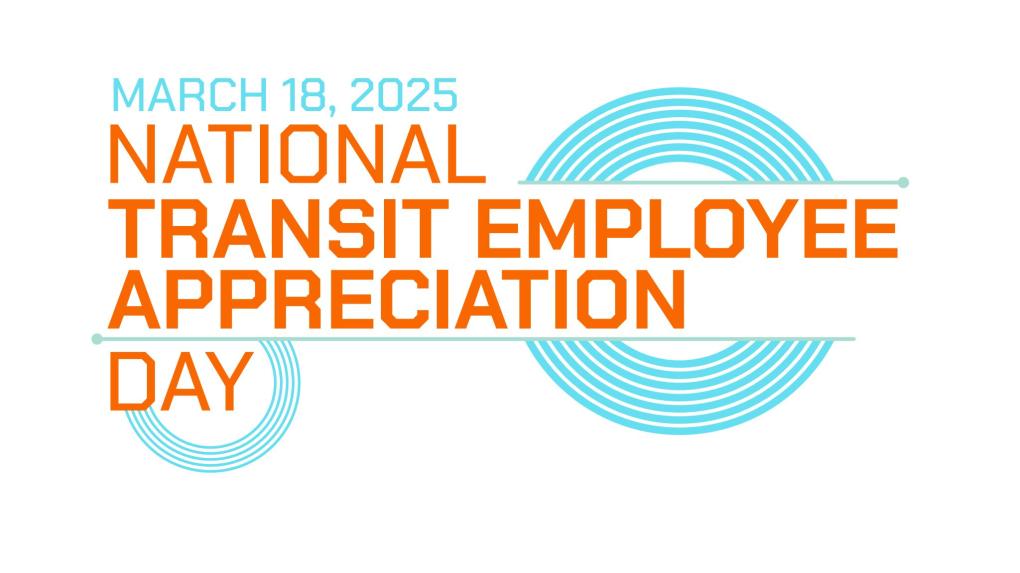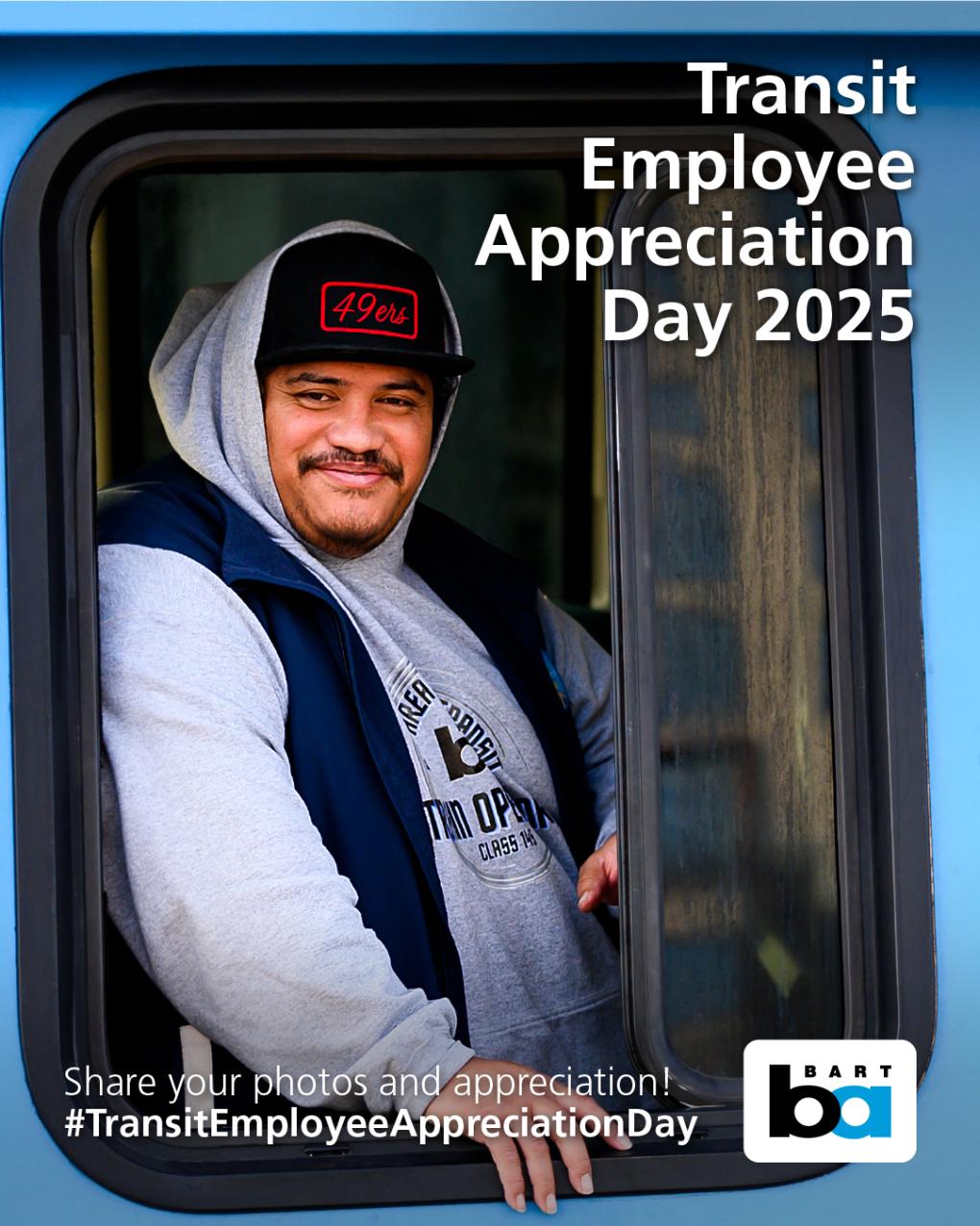Search Results
The Role in the Region Report
Stimulus bill increases transit tax benefit for commuters
The Emergency Economic Recovery Act signed into law by President Obama this week provides significant tax savings, up to $1,000 or more a year, to working Americans who commute by transit. The law raises the amount of pretax income that workers enrolled in employer-sponsored commuter benefits programs can use
Public hearing on fare increase, parking fee changes set for May 28
NOTICE IS HEREBY GIVEN THAT: Preliminary budget pamphlets of the San Francisco Bay Area Rapid Transit District concerning its preliminary annual budget for the fiscal year July 1, 2009, to June 30, 2010, were made available beginning April 9, 2009, to persons requesting them at the Office of the District
Celebrating National Transit Employee Appreciation Day!
Give a wave and words of thanks to BART employees you see today – it's National Transit Employee Appreciation Day!
Every year on March 18, public transit agencies across the nation celebrate the amazing work forces that keep us moving, our economies humming, and our air clean. It's a big job moving the Bay Area, and BART's employees do it with dedication, care and moxie. We appreciate them and hope you do to.
We asked some of our riders to share a message to our employees – hear from them in the video in this article.
On this notable day, BART invites the public to share their gratitude for hardworking transit employees. They appreciate knowing you value them. So, if you’re traveling on transit today, take a moment to say “thanks” to the staff who make your trip possible. A smile or wave goes a long way, too!
Additionally, keep an eye out for signs of gratitude in our stations, including some of our employees featured on posters in station agent booths, and listen for a special PA announcement recorded by BART General Manager Bob Powers.
We can't express enough gratitude to our employees, who are working hard every day to provide high-quality train service to our customers.
And the proof is in the pudding: Last quarter, we elevated our overall customer satisfaction rating to 81%, an increase of 7% from the previous quarter. This is the first time since 2012 that our customer satisfaction rating has broken the 80s! We have our employees to thank for that.
Thank you, BART staff and all the transit employees across the nation. This day is for you!

Read about some of our amazing employees
Cleaner trains than ever: Meet the team that has five minutes to clean every BART train
With $300 in her wallet and a dream, one BART track operator forged her own path
BART Chief of Police on BART’s 1972 opening day and a lifetime riding trains
Serial entrepreneur turned Station Agent trainee reflects on his journey to BART
10 Questions with Train Operator Shinita Garza
BART employee stars in new film about famed sign spinner
Train Car Electricians are the neurosurgeons of BART
BART trains now deep-cleaned twice as often -- meet the employees who make it happen
Dispatchers are the “behind-the-scenes heroes” of BART Police
Financial Analysts at BART meld science with art
Train Car Mechanics keep BART trains on the go
Podcast: A lifelong passion for transit inspires a BART Supervisor to improve your ride
From the third rail to station lightbulbs, BART Electricians keep the system energized
BART's Mark Nagales honored his grandmother’s memory with one final trip on a legacy train
What it takes to deep clean a BART station – a process BART recently doubled in frequency
Bay Area transit systems release Healthy Transit Plan
Bay Area transit agencies are uniting with the common goal of providing a safe ride for the public as the region responds to the coronavirus (COVID-19) pandemic. The core of this effort is the newly released “Riding Together: Bay Area Healthy Transit Plan.” The plan outlines action items for frequent cleaning
Updates on weekend service outage in downtown Oakland
(For the most up to date information on BART service delays please visit bart.gov/advisories.)
Update: Tuesday, July 30 (4:30pm)
Red Line service has been reestablished. We will operate with speed restrictions in the downtown Oakland core while repairs are made to the damaged gap breaker station. There is currently not an estimate for how long those repairs will take to complete.
Update: Monday, July 29 (2:00pm)
There’s currently no Red Line service due to ongoing power issues in downtown Oakland. This is being done out an abundance of caution to ensure continued service to Oakland stations.
East Bay riders who would normally use the Red Line to travel transbay can instead take an Orange Line train and transfer to a Yellow Line train at MacArthur Station. A shuttle train is operating between Millbrae and SFO stations.
UPDATE: Monday, July 29 (6:00am)
Red Line service is restored so we have full service on all lines.
UPDATE: Sunday, July 28 (10:47am)
All Oakland stations are open after an earlier loss of power. Service has resumed between MacArthur, Coliseum, and West Oakland stations. All lines are running, excluding the Red Line, which remains out of service.
Expect major delays systemwide.
UPDATE: Sunday, July 28 (10:11am)
Fruitvale and Lake Merritt stations are now open, and Green Line service to Daly City has been restored. 12th St./Oakland and 19th St./Oakland stations remain closed.
AC Transit is providing bus service between MacArthur, Coliseum, and West Oakland stations.
Use the BART Trip Planner on bart.gov or the BART app to find transit alternatives based on your location by deselecting BART in "transit options." View a map of bus and ferry alternatives at bart.gov/transbayalts.
UPDATE: Sunday, July 28 (9:04am)
BART continues to have no service in the core of its system in Oakland. The following stations remain closed: Fruitvale, Lake Merritt, 12th St/Oakland, and 19th St/Oakland. Trains are turning back at Coliseum, West Oakland, and MacArthur stations.
There is currently no Red Line or Green Line service. The cancelled service may not be reflected on station screens.
AC Transit is providing service between the four closed stations, and BART staff are positioned outside of the stations to assist customers. Bus service begins at Coliseum Station, West Oakland, and MacArthur stations. Transbay service is running. You can take a Yellow Line or Blue Line train to and from West Oakland to cross the bay.
Use the BART Trip Planner on bart.gov or the BART app to find transit alternatives based on your location by deselecting BART in "transit options." View a map of bus and ferry alternatives at bart.gov/transbayalts.
Crews are working around-the-clock. Further updates will be provided.
UPDATE: Sunday, July 28 (7:55am)
BART continues to have no service in the core of its system in Oakland and the following stations remain closed: Fruitvale, Lake Merritt, 12th St/Oakland and 19th St/Oakland. Trains are turning back at Coliseum, West Oakland and MacArthur Stations.
Bus service is being provided between the four stations and BART staff are positioned outside of the stations to assist customers. Use the BART Trip Planner on bart.gov or the BART app to find transit alternatives based on your location by deselecting BART in "transit options." View a map of bus and ferry alternatives at bart.gov/transbayalts
This is due to a power loss at a substation that began at approximately 5pm on Saturday, July 27th. The suspected cause is a blown breaker, which caused a major electrical short that essentially short circuited the trackway in that area.
At approximately 5:20pm on Saturday, July 27, we experienced a disruption in service between 12th St/Oakland and Fruitvale stations due to a power issue at an Oakland substation.
As a result, four stations were closed. They are Fruitvale, Lake Merritt, 12th St/Oakland and 19th St/Oakland. Trains are turning back at Coliseum, West Oakland, and MacArthur stations.
Use the BART Trip Planner on bart.gov or the BART app to find transit alternatives based on your location by deselecting BART in "transit options." View a map of bus and ferry alternatives at bart.gov/transbayalts
(This article was originally published on Saturday, July 27)
Rockridge construction to temporarily limit daily fee and permit parking
Dear Customer: We will need to temporarily relocate some Daily Fee and Permit parking spaces as we continue our Earthquake Safety Program construction. Daily Fee spaces will be temporary relocated in the overflow Permit parking spaces in the upper portion of the western lot only. Additional parking for Permit
Expect delays on Daly CIty trains Sat, Feb. 28 and Sun, March 1
From Saturday, February 28 at 1:30am to Monday, March 2, at 3:30am, a variety of BART crews will mobilize at the Daly City Station to work continuously through the weekend. Expect delays of 10 to 15 minutes. Crews will complete a large list of repairs and improvements from platform and concrete work to
Phase II electrical work starts March 9 at MacArthur Station
Starting the week of March 9, 2015, we will finish up Phase I and begin Phase II of the electrical work at MacArthur Station by moving the scaffolding from the north side of the station to the south side and sectioning off areas of the station to do the needed electrical work. Because there is some asbestos
Downtown Berkeley station main entrance/Center Street Closes 8/14/17
The main entrance (Center Street) is scheduled to close 8/14/2017 as part of our Plaza Improvement Project. At the same time, we will close the entrance at the corner of Addison St. West and Shattuck Avenue. The main street entrance and Addison St./Shattuck entrance will reopen in the Fall 2018. The access to




